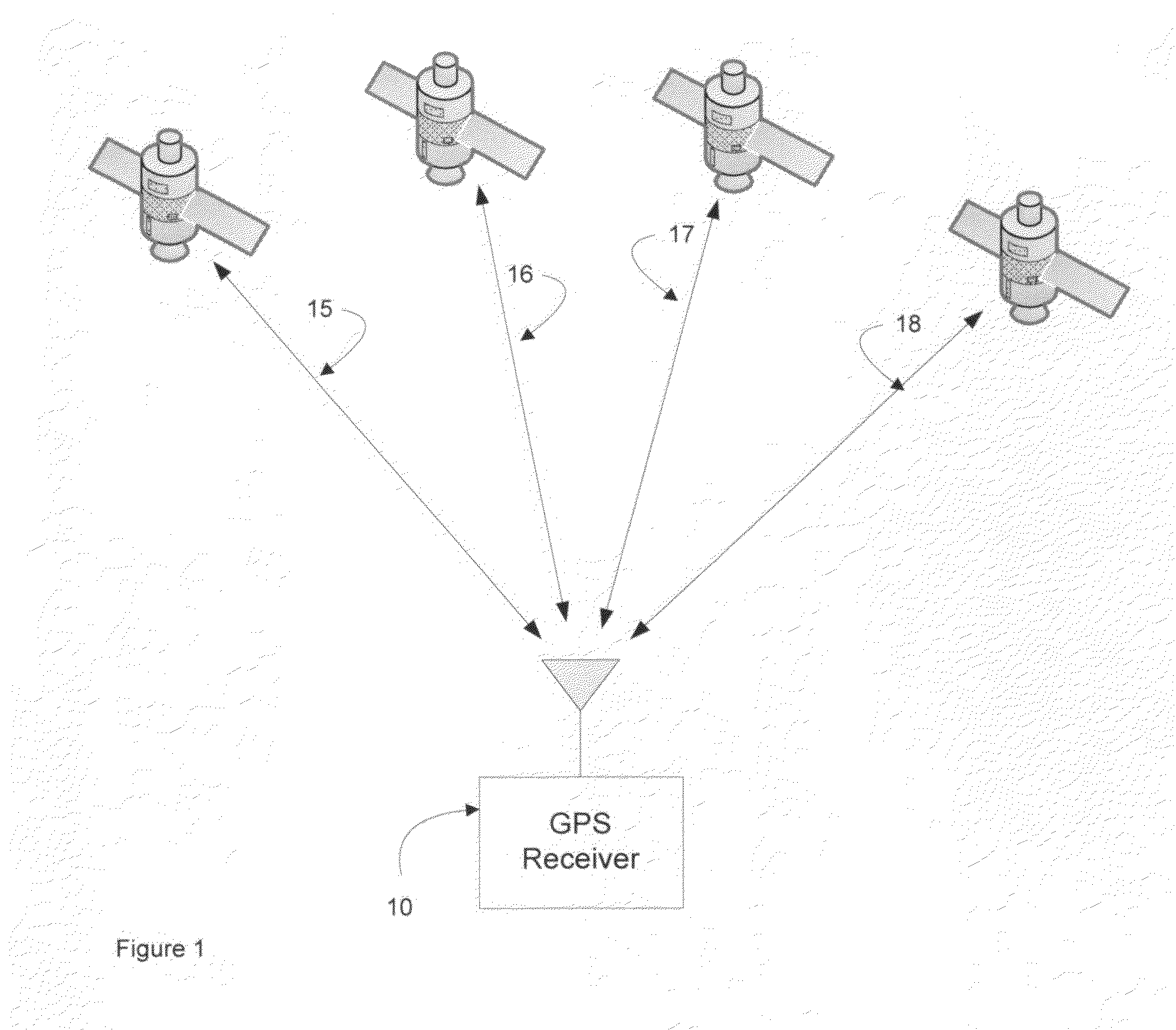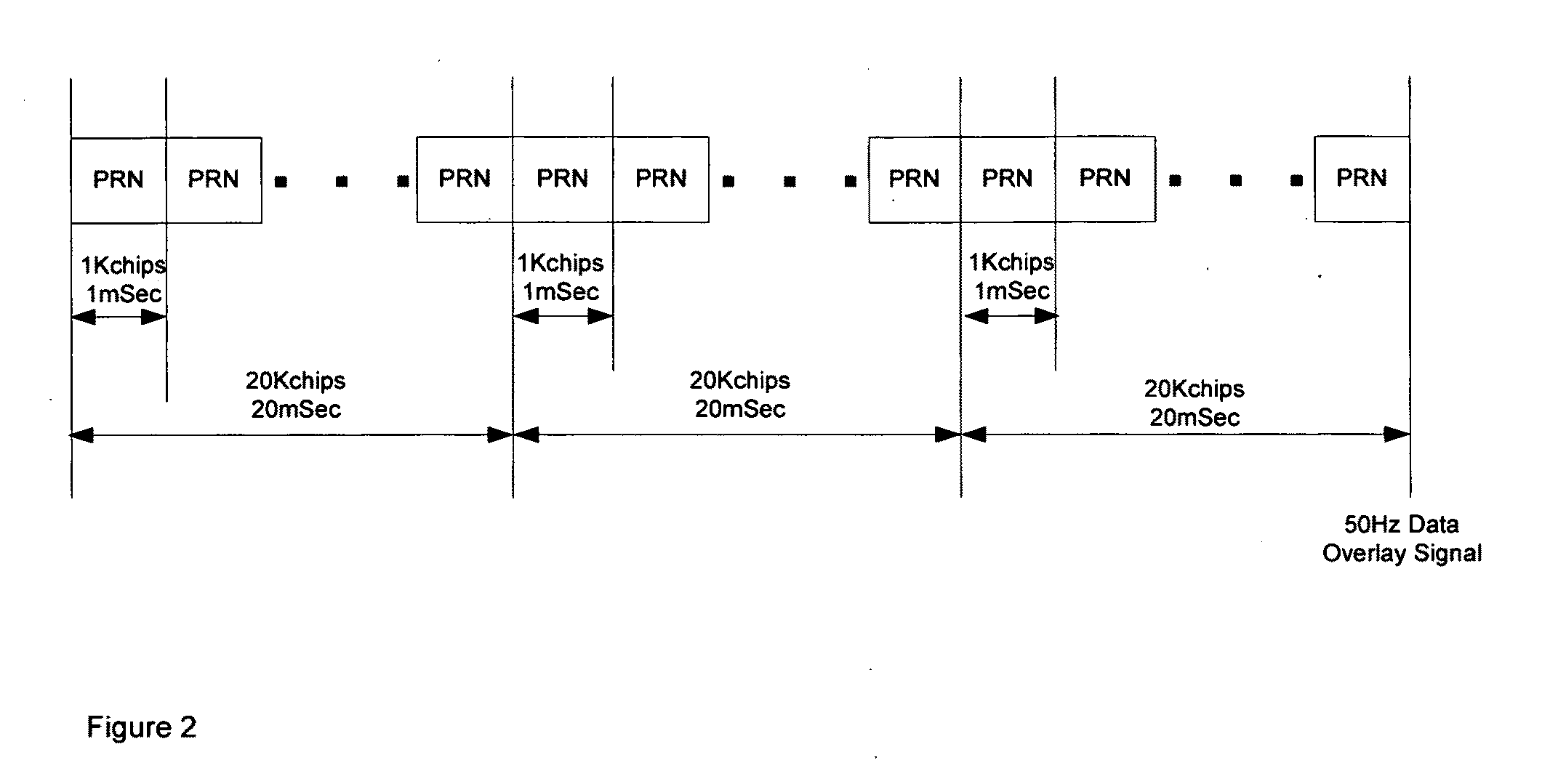[0009]In order to overcome the TTFF disadvantages of
GPS receiver 30, a prior art GPS
receiver 50, with GPS assistance
system 59 has been introduced (see FIG. 5). The role of GPS assistance
system 59 is to track, the satellites “acquirable” in the vicinity of GPS assistance system 59. Accordingly, the GPS signal from GPS
satellite constellation 56 is received by the R / F front end 51 of GPS
receiver 50. R / F front end 51 down converts the 1.57 GHz R / F signal, resulting in an
intermediate frequency (I / F) signal. The streaming I / F signal is examined by correlator 52, which is used to acquire satellites. To expedite the acquisition process, frequency information derived by GPS assistance system 59 in the course of tracking acquirable satellites, is transmitted to GPS
receiver 50. This information is used to set the local frequency used by the
search algorithm of correlator 52, enabling the
search algorithm to operate more efficiently and more effectively. As a result the TTFF is significantly reduced, and receive sensitivity is improved slightly at the margin. Once pseudo range information has been determined for a minimum of four
GPS satellites, the location coordinates are determined by coordinate generator 55. In addition to frequency information,
ephemeris parameters may be transmitted to GPS receiver 50 from GPS assistance system 59. This information, however, does not affect the receive sensitivity of GPS receiver 50.
[0013]In general, the object of the present invention is to provide methods and apparatus to increase the receive sensitivity of GPS receivers in order to provide for the reliable determination of location coordinates in indoor and urban
canyon operation. To this end, novel
signal processing techniques reducing the minimum
signal strength required to acquire a satellite in indoor and urban
canyon environments are disclosed. The use of multiple GPS sensors provides the conceptual framework for such techniques. In this context, GPS sensors are characterized as one of two types: target GPS sensors, whose location is to be determined; and reference GPS sensors, used in the derivation of a reference used to increase the receive sensitivity of target GPS sensors.
[0014]The reduction in the minimum
signal strength required to acquire a satellite (characterized as an increase in receive sensitivity) results from two types of innovation. To enable these innovations, the prior art GPS receiver has been rearchitected, as described in FIG. 6. In addition to the repartitioning of the basic functions—opening the
signal processing platform to sophisticated techniques—the concept of the perfect reference is introduced, which in turn enables the second innovation—a buried-signal
equalization technique effective in reducing if not eliminating the effects of multi-path.
[0015]Specifically, the invention postulates the embedding of simple GPS sensors at the points of measurement, receiving and recording signals transmitted by navigational satellites, and forwarding the recordings (datagrams) to central datagram processing facilities. Significant in this partitioning is the fact that this enables a practical solution to the challenge of processing large datagrams, which in turn enables
signal processing gains that translate into a reduction in the minimum
signal strength required to acquire a satellite.
[0016]Exploiting the opportunity enabled by this repartitoning, and mindful of the utility of multiple sensors, a signal processing technique called perfect reference generation has been developed. Perfect reference generation is a
novel technique for optimizing the extraction of pseudo ranges from datagrams recorded at target GPS sensors, whether by correlation or by
equalization techniques. The perfect reference, extracted from a datagram recorded at a reference GPS sensor designated for the express purpose of perfect reference generation, is a reconstruction of the transmitted signal based on the analysis of large datagrams. In the process of perfect reference generation, satellite timing is derived, thus eliminating the requirement for a fourth satellite to fix location coordinates, and further reducing the minimum signal strength required to acquire a satellite.
[0017]Finally, classic
equalization concepts have been adapted to the case in which the signal is buried in
noise; with the leverage of the perfect reference, the recombination of multi-path signals is reduced to a tractable mathematical formulation. As a result, the minimum signal strength required to acquire a satellite is reduced even further.
 Login to View More
Login to View More  Login to View More
Login to View More 


